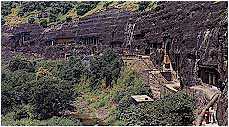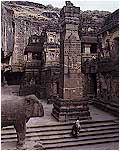
(HISTORY) STUDY TOUR. AUGUST 1997
We went to Aurangabad for a History tour in the month of august. We went there to study the early civilization,this study was possible by studing the Ajanta and the Ellora caves.The time we were in Aurangabad besides Ajanta and Ellora we visited the Bibika-Makhabara and the Daulatabad fort.
Ajanta and Ellora Caves.
The state of Maharashtra is home to the enchanting Ajanta and Ellora group of caves. The cave shrines were all cut out of rock, by hand,and rank amongst some of the most outstanding specimens of ancient Indian architectural heritage. The 34 caves at Ellora and the 29 caves at Ajanta, were hidden from the public eye, till they were accidentally rediscovered in the 19th century.
Ajanta Caves:

It was only in the 19th century, that the Ajanta group of caves, lying deep within the Sahyadri hills, cut into the curved mountain side, above the Waghora river, were discovered. A group of British officers on a tiger hunt, stumbled on these ancient works of art.
They depict the story of Buddhism, spanning the period from 200 BC to 650 AD.The 29 caves were built as secluded retreats of the Buddhist monks, who taught and performed rituals in the Chaityas and Viharas, the ancient seats of learning, and nerve - centres of the Buddhist cultural movement. Using simple tools like hammer and chisel, the monks carved out the impressive figures adorning the walls of these structures. Exquisite wall - paintings and sculptures speak volumes of the India of yore. Many of the caves house panels depicting stories from the Jatakas, a rich mine of tales of the several incarnations of the Buddha. Images of nymphs and princesses amongst others, are also elaborately portrayed.
Cave 1 houses some of the most well - preserved wall paintings which include two great Boddhisattvas, Padmapani and Avalokiteshvara. Caves 2 , 16 and 17 also contain amazing paintings, while Caves 1, 4, 17,19, 24 and 26 boast of some of the most divine sculptures. The flying apsara, of Cave 17, and the image of Buddha preaching in Cave 17, are a couple of unforgettable works of art. The Ajanta caves and the treasures they house, are a landmark in the overall development of Buddhism as such.
Ellora:

The Ellora caves, 34 in number, are carved into the sides of a basaltic hill, 30 kms from Aurangabad. The finest specimens of cave -temple architecture, they house elaborate facades and exquisitely adorned interiors. These structures representing the three faiths of Hinduism, Buddhism and Jainism, were carved during the 350 AD to 700 AD period. The 12 caves to the south are Buddhist, the 17 in the centre dedicated to Hinduism, and the 5 caves to the north are Jain.
The sculpture in the Buddhist caves accurately convey the nobility, grace and serenity inherent in the Buddha. Caves 6 and 10 house images from the Buddhist and Hindu faith, under the same roof, the latter dedicated to Vishwakarma, the patron saint of Indian craftsmen.
The Vishvakarma cave is both a Chaitya and a Vihara, with a seated Buddha placed in the stupa. Its two - storeyed structure sports a colourful pageant of dwarfs, dancing and making music. The Kailasa temple in Cave 16 is an architectural wonder, the entire structure having been carved out of a monolith, the process taking over a century to finish. This mountain - abode of Lord Shiva, is in all probability, the world's largest monolith, the gateway, pavilion, assembly hall, sanctum and tower, all hewn out of a single rock. What is amazing about it is the fact, that unlike other temple structures which are built base onwards, the sculptor or architect involved here,started carving from the very top and the sides. Gigantic, though it is, it remains one of the most delicate and intricate ancient works of art.
The Dumar Lena cave resembles the famous cave - temple at Elephanta, and is dedicated to Lord Shiva.The Jain caves are about a mile away from the Kailasa temple, amongst which Cave 32, houses a beautiful shrine adorned with fine carvings of a lotus flower on the roof, and a yakshi on a lion under a mango - tree, while Caves 32 and 34 contain grand statues of Parasnath. The other Jain caves sport the images of Tirthankaras, and one of them, also, has a seated figure of Mahavira. These cave shrines are memorable for their invaluable contribution to the enormous wealth of Indian heritage.
CASE STUDY OF A MUSEUM. NOVEMBER 1997.
Gujarat state is renowned for its holy temples, historic capitals replete with immense architectural wealth,wildlife sanctuaries and hill resorts. The fascinating handicrafts,and colourful lifestyle of the people of Gujarat, are renowned all over the country.The recently excavated ancient port of Lothal, near Ahmedabad, bears testimony to Gujarat's 4,500 years of history. An important trade centre of the pre - Aryan Harappan civilization, Lothal had trade links with the ancient civilizations of Sumer, Babylon and Egypt.With the Arabian Sea lapping its western frontier, Gujarat has been exposed to a succession of alien races. In the process, it has imbibed elements of a variety of cultures, and yet retained its cultural individuality.
Vadodara .Once the capital of the princely Gaekwads, Vadodara is a graceful city of palaces, parks, temples and museums. The Nazarbagh Palace, Makarpura Palace, Pratap Vilas Palace, Maharaja Fateh Singh Museum,Vadodara Museum, Picture Gallery and Kirti Mandir are the major attractions of the region.